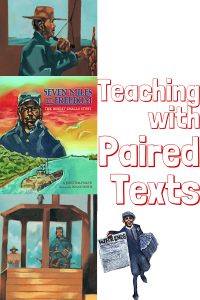In the fall of 2012 a news story emerged that astronomers had discovered a planet largely made out of diamond. Third grade at my school spent the first two quarters studying the solar system; therefore, this news was received with irrepressible glee in my classroom. Although the media nickname “Lucy” was lost on my students (as in the Beatles’ “Lucy in the Sky with Diamonds”), the wonderment and rejuvenated commitment to the content were obvious.
Seeing that scientists were still studying and discovering facts about our solar system and distant others was exciting to my students and made them feel like they were on the frontier learning alongside real astronomers. Pairing the news article with The Magic School Bus: Lost in the Solar System spurred very creative journal entries throughout the unit, including envisioned future discoveries of all sorts of substances for planets: kitten fur, gold, bubbles.
Incorporating current events and news stories into the classroom can engage students with a renewed sense of purpose and interest. Pairing a news article with a book on a similar topic or theme offers students greater context and a sense of relevancy for the content they are learning, and perhaps a jolt to the creeping apathy over a curriculum students had little input in selecting.
 So, what does it look like to use paired texts in the classroom?
So, what does it look like to use paired texts in the classroom?
One example is using the picture book biography, Seven Miles to Freedom: The Robert Smalls Story. In May 2014, the National Oceanic and Atmospheric Administration (NOAA) announced it had discovered the Civil War ship of Robert Smalls. Pairing one of the articles with the picture book biography provides students opportunity to practice comprehension and the third component of the Common Core reading standards: integration of knowledge and ideas.
Standard 9: Analyze how two or more texts address similar themes or topics in order to build knowledge or to compare the approaches the authors take.
The following example can be adapted for grades 3–7. Read the picture book, Seven Miles to Freedom, aloud to the whole group or have students read to themselves depending on their reading level. Focus questions may look like this:
- How does the picture book describe Robert Smalls?
- What character trait would best describe Robert Smalls based on what he says, does, thinks, feels and what other characters say and think about him?
- Why do you think the author of the picture book wants to share this story with young people?
- How does this story help us better understand the events in Robert Smalls’ life?
Read the news article second. If the news article is above students’ reading level, read the article aloud as they follow along with individual copies. The questions for the article will mirror those questions for the picture book:
- How does the article describe Robert Smalls?
- What character trait would best describe Robert Smalls based on what he says and does and what other people quoted say and think about him in this article?
- Why do you think the NOAA’s Maritime Heritage Program wants to find and rescue the ship/signify the ship’s location now after all these years?
- How does this news article help us better understand the events in Robert Smalls’ life and the picture book Seven Miles to Freedom?
Follow up questions looking at both texts together:
- What events and details do both texts agree on?
- Create a timeline of events using both the picture book and news article.
- How are these texts both examples of nonfiction? What sub-genres of nonfiction are they? How do they present information similarly and differently?
Resources about Robert Smalls:
- Explore a reading guide and learning activities for Seven Miles to Freedom from OurStory, a website created by the Smithsonian’s National Museum of American History to encourage adults and children in grades K–4 to read historical fiction and biography together
- Read about Robert Smalls’ ship, Planter, and a report about the discovery from the Voyage to Discovery, a multi-media initiative to highlight African American maritime history from the NOAA’s Office of National Marine Sanctuaries’ Maritime Heritage Program and the National Association of Black Scuba Divers
Resources for teaching current events in the classroom:
- Three Teacher-Tested Ways to Encourage Your Students to Follow Current Events This School Year (NYTimes)
- 50 Ways to Teach with Current Events (NYTimes)
Bonus: A fragment from Amelia Earhart’s airplane was recently identified. What book would you want to pair with this news story for students? Share with us!
Jill Eisenberg, our Senior Literacy Expert, began her career teaching English as a Foreign Language to second through sixth graders in Yilan, Taiwan as a Fulbright Fellow. She went on to become a literacy teacher for third grade in San Jose, CA as a Teach for America corps member. She is certified in Project Glad instruction to promote English language acquisition and academic achievement. In her column she offers teaching and literacy tips for educators.



Amelia and Eleanor Go for a Ride by Pam Munoz Ryan, of course! 🙂
Hi Miss Amy-
Thank you for recommending the book, Amelia and Eleanor Go For A Ride, as a book pairing to the article about the discovery of Amelia Earhart’s plane fragment. This is a fantastic story about persistence, courage, and overcoming obstacles. I could see students engaging on additional research projects and personal narratives with this pairing!